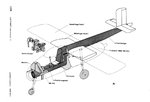Shortround6
Lieutenant General
Changing an engine or changing armament on a prototype or a couple of "test" airplanes as "proof of concept" is one thing. Doing a properly "engineered" installation is another. Least amount of ballast needed, proper access for maintenance, proper cooling under a variety of conditions. And perhaps even more important, the design and construction of the different jigs and fixtures needed for mass production. Most of the work on the jigs and fixtures cannot begin until the actual changes are finalized in the test program. A jig for the location and drilling of the radiator mounting holes is pretty much useless if the radiator is changed or even moved and inch in regards to the datum line or locating holes for the jig.
Russian "mass production" without proper jigs and fixtures often lead to low serviceability in the field because not only did parts from different factories not fit properly but at times parts from the same factory were not interchangeable and needed to modified to "fit".
Russian "mass production" without proper jigs and fixtures often lead to low serviceability in the field because not only did parts from different factories not fit properly but at times parts from the same factory were not interchangeable and needed to modified to "fit".

